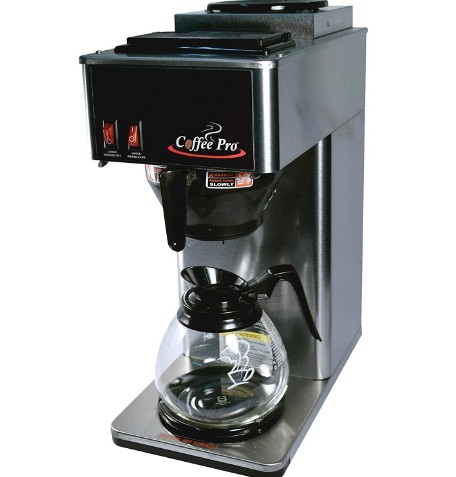A Keurig is a single-brew coffee maker created to be practical and simple to use for grabbing a quick cup of hot coffee.
While using a Keurig is straightforward once you get the hang of it, there are a few other crucial aspects of its use that you should be aware of, including initial setup, automatic modes (which are only available on some Keurig models), maintenance, draining the machine’s internal water tank, and Keurig alternatives if that appliance doesn’t seem like the best fit for you.
Table of Contents
How To Use A Keurig: Initial Setup & Cleansing Brew
Your Keurig needs to be set up and its internal components flushed with water before you use it for the first time.
1. Unbox Your Brewer And Plug It In
Grab the package, take the Keurig brewer out of the packaging, untie the tape holding some of the parts together, and plug it in.
Don’t forget to save the user guide. There is a wealth of useful information about using and caring for your particular Keurig model in there.
2. Lift The Handle And Discard The Shipping Disc If Included
Brewers without a shipping disc are not subject to this step.
In the pod attachment, some brewers include a temporary disc. Lift the handle and take it off if yours is one of these designs.
But don’t just toss the shipping disc in the trash! I might be a pack rat, but I’d advise keeping the disc with the original packaging and user guide. You never know when you might need to put the brewer away, whether it’s to move, give or sell to someone else, or send back to the manufacturer.
3. Remove The Water Reservoir And Clean It With Soap And Warm Water
Brewers from the K10, K15, and B31 Mini series that have a fixed water reservoir are exempt from this step. At this point, our only goal is to thoroughly clean the water reservoir in preparation for use.
Remove the water reservoir and clean it with a soft cloth or sponge, soap, and warm or hot water. Use a smooth Brillo pad instead of a rough one!
Don’t forget to wipe down the water entry point at the base of the water reservoir platform, making sure there’s nothing in there you don’t want in your coffee
4. Prime The Charcoal Water Filter
Brewers without a kit for a charcoal water filter are exempt from this step.
It is not intended to open the charcoal water filters and set them in the water filter holder right away. Instead, prime it by following these simple steps:
- Rinse it under cool water for a minute, ensuring it soaks up all the water it’ll take
- Soak it in a bowl of water for 5 minutes
- Massage the water filter so that any loose charcoal particles fall away into the bowl of water and not into your coffee
5. Insert The Charcoal Water Filter Into The Water Filter Handle And Snap Into The Reservoir
Brewers that don’t come with a charcoal water filter kit are exempt from this step.
The charcoal water filter holder has two parts as shown above:
- Bottom pod holder
- Top handle that snaps onto the bottom
The handle should be placed over the charcoal water filter and the assembled water filter should be inserted into the water reservoir. Everything will fit together snugly.
6. Fill The Water Reservoir To The Max Fill Line
Use your tap water to fill a charcoal water filter if you have one. Make sure to fill the water reservoir with spring or filtered water if you don’t have a filter.
7. Press The Power Button And Wait For Preheating To Complete
This could take anywhere from 20 seconds to 3 minutes, depending on your model.
8. Grab A Mug And Place It On The Drip Tray
Some models come with a censor that won’t start brewing unless a mug is placed on the drip tray. Avoid making a mess even if there isn’t!
9. Lift And Lower The Handle Without Inserting A Keurig Coffee Pod
I mean, you could use a coffee pod, but this is our cleansing brew so no sense in wasting coffee.
10. Select The Maximum Size Brew Setting And Press Brew
Never choose a size bigger than the mug you’re using!
Depending on your model, the brewing time for your coffee-free coffee will take anywhere from 30 to 3 minutes. Once it’s finished, you can consider the internal parts thoroughly rinsed and start using your Keurig brewer every day.
Why Isn’t My Keurig Single Serve Working?
You might need to reset your Keurig if it won’t start brewing. It’s possible that the water reservoir’s settings are off or that it was built improperly. Your brewer may require descalement, which involves removing mineral deposits from the tank and tubes, if you want to prevent mineral buildup.
Keurig coffee makers frequently have problems because of the accumulation of scale and debris on the dispenser. Rinse the appliance in water or vinegar if you think there may be calcium scaling present. Make sure that everything is in its proper place and that you are seated comfortably. It is common to find magnetic water reservoirs that are not aligned. The water reservoir’s magnet regularly becomes loose when the machine is subjected to vibrations. If the issue continues, you should get in touch with Keurig customer service. Water lines in coffee makers frequently clog.
Maintaining Your Keurig Machine
We’ll get this out of the way first: never immerse your Keurig machine submerged in water. The machine’s internal electrical system will be harmed by this. So how do you clean a Keurig?
It’s recommended that you clean out your Keurig at least every three to six months. White vinegar or Keurig descaling solution are used for this. Since the Keurig accumulates mineral deposits over time, it needs to be cleaned.
First, pour vinegar or the descaling solution halfway into the water reservoir, then start the brewing process. Continue until the water reservoir is empty. Repeat this procedure once more, but this time use plain water.
To clean your Keurig’s exterior, use a wet cloth and soap. This ought to assist in removing any dirt and surplus coffee residue. By taking the water reservoir out of your Keurig and rinsing it, you can also clean it.
If the drip tray fills up, empty it, wipe it down with a wet, soapy cloth, and then rinse it. If you have a dishwasher, you can also wash the drip tray; it will fit best on the top rack.
Although you won’t need to do it frequently, you should always run the cleaning cycle after making sticky beverages like hot chocolate or more sweetened coffees. To avoid sugar crystallizing in the machine, simply run a brewing cycle with hot water.

Keurig Auto-brew And Auto-on
There are two different kinds of automatic brewing modes. The first is auto-brew. In this mode, you can schedule the brewing of a specific coffee pod at a specific time on a Keurig coffee maker that is currently filled with water.
You can choose when you want the coffee to start brewing by simply selecting the “auto brew” option on the display or the auto brew button.
On the other hand, the auto-on mode merely enables you to specify a time for the device to begin preheating.
How Can I Choose The Keurig That’s Best For Me?
There are numerous Keurig models available on the market. In all honesty, it really comes down to personal preference.
There’s a few questions to ask yourself when looking into buying a Keurig that can help:
- Is a simple model sufficient for me, or do I need one of the more complicated ones?
- Does my kitchen have enough counter space for one of the larger models?
- What kind of money can I afford to spend on one of these?
Conclusion
Most single-cup coffee makers only require you to insert a coffee pod and choose the size of your preferred mug to use them. For coffee brewing to be possible, you must also understand how to fill the water reservoir of the appliance. Even if you don’t own one yourself, single-cup coffee makers are becoming more and more common in homes, offices, and businesses. You never know when you might run into one in a break room or waiting area.



